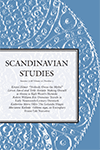Quite excited to see this article appearing:
Toponyms as Prompts for Presencing Place—Making Oneself at Home in Kjell Westö’s Helsinki. Lieven Ameel and Terhi Ainiala.Scandinavian Studies. Vol. 90, No. 2 (Summer 2018), pp. 195-210.
Based on a close analysis of the use of place names in Westö’s Lang, and on empirical data gathered with two groups of students at the University of Helsinki, this article brings new perspectives on how readers make sense of literary storyworlds with the help of toponyms, including new insights on how toponyms are drawn upon when reading in translation, when unacquainted with the places in question, or when the author uses both invented and actual, referential place names.
Thanks to my co-author Terhi Ainiala, to all students who participated, to everyone who commented in various stages, and to Scandinavian Studies for publishing this!
Opening page:
“Literary Toponyms: Setting in Place a Storyworld
Amongst spatial delineators involved in literary worldmaking, place names take on important, though often undervalued, meaning. How do literary place names evoke the “feel” of a literary place, and by doing so, co-operate in constructing the narrative world? How do they guide the reader in coming to terms with the storyworld? And what are the consequences of these processes when readers are distanced from place-names, either because they live in another time and place than the original intended audience, or because they are separated from the storyworld by differences in language and culture? These questions will be framed here within the context of a bilingual Northern European city rendered in literature, and with specific reference to how foreign readers make sense of literary place names when reading a text in translation.
This article examines the functioning of toponyms as prompts for presencing place in Finnish literature set in the Finnish capital Helsinki/Helsingfors. Our analysis will focus on Lang (2002), written in Swedish by the Finland-Swedish author Kjell Westö, a novel that will be discussed in its wider context of Helsinki literature, including other work by Westö. A novella in Finnish by Juhani Aho from the turn of the twentieth century will be used as an introductory text. In terms of underlying theoretical apparatus, our study draws on recent advances in the study of toponyms, and specifically in the functional-semantic and sociolinguistic view on proper names (see e.g. Ainiala, Saarelma, and Sjöblom 2012). It also draws on new directions in literary spatial studies, geocriticism (Westphal 2007), and literary urban studies (see e.g. Ameel, Finch, and Salmela 2015). In literary research published in the long wake of the spatial turn, space is no longer primarily considered as a question of description. Attention is given, rather, to the close interconnection between literary space and the dynamics of plot and character development (cf. Ameel 2014; Ette 2005; Moretti 2005; Pultz-Moslund 2011). Spatial environments are the prerequisites for a story to unfold, and instrumental in moving the plot forwards (Moretti 1998, 3ff.).
We will juxtapose a literary analysis of the selected texts with the findings from a survey of Finnish and non-Finnish readers’ associations of place-names in the Helsinki texts. The survey was carried out in the spring of 2015 at the University of Helsinki. Two groups of readers, 10–15 each, participating in separate literary courses, were asked to fill in questionnaires that contained multiple-choice and open-ended questions about the associations and the functions of toponyms in the novels read during the respective courses. A total of twelve novels and novellas were read by each group. One course was given in Finnish, aimed at Finnish students, while the other course was conducted in English and aimed at exchange students who read the novels in translation. The distinction between the groups was not clear-cut: in the “Finnish” group, there were several students with Finnish language proficiency who did not have either Finnish or Swedish as their mother tongue, while the “foreign” group included some students with a notional knowledge of Finnish. In the case of literary texts by Finland-Swedish authors that were discussed during the course, most students in the “Finnish” group read these in translation, too, preferring to use the translation rather than the Swedish original. The surveys enable us to examine questions regarding the use of toponyms in literary fiction—questions that have, in the existing research literature, remained largely unanswered—with unique empirical data.
Our prior hypotheses revolved around the assumption that a lack of knowledge of a toponym’s connotations could impair the abilities of the reader to identify character dynamics and plot evolutions based, for example, on a character’s socio-economic backgrounds, or the moral make-up of particular locations. As we will argue in the analysis, other meaning-making elements, too, appeared from the responses to the questionnaires: these include the semantic meaning of toponyms, as well as the extent to which the dynamics in the literary text itself attribute meaning to locations and to the toponyms that refer to them, independent from the reader’s prior knowledge of the actual locations referred to.”

